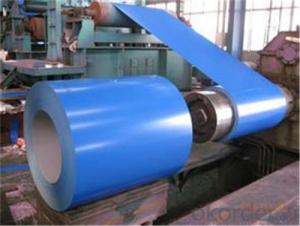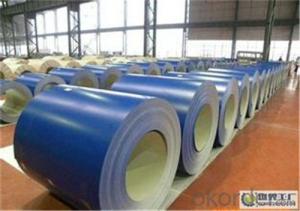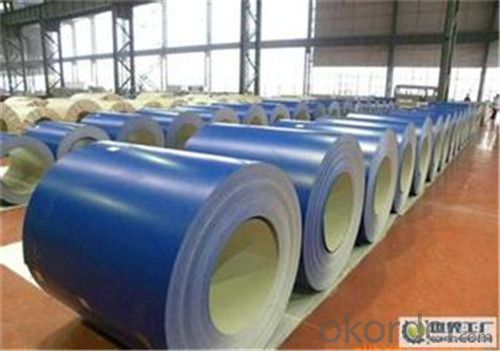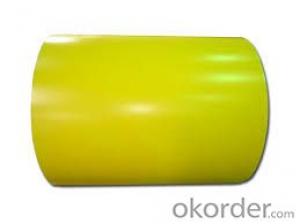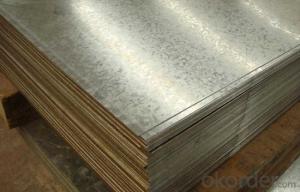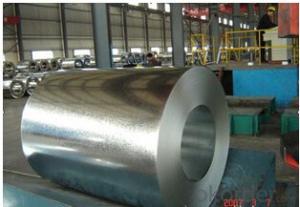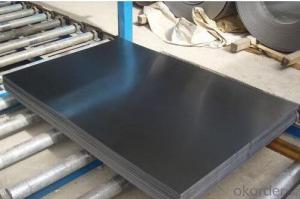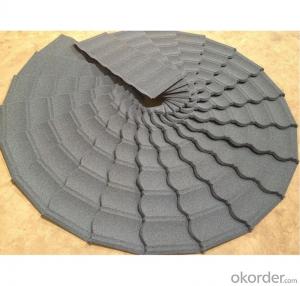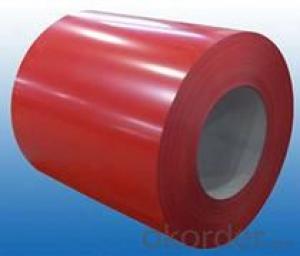Galvanized Corrugated Steel Plate / Sheet in China CNBM
- Loading Port:
- Tianjin
- Payment Terms:
- TT or LC
- Min Order Qty:
- 140 m.t.
- Supply Capability:
- 500000 m.t./month
OKorder Service Pledge
OKorder Financial Service
You Might Also Like
Brief Introduction of Prepainted Galvanized Steel:
Prepainted Galvanized Steel usually refers to have substrate processed with surface processed and coated then(roller coated )or bonded organic thin film and baked, and it is able to be processed to final production .
Description of Prepainted Galvanized Steel:
1.material : galvanized steel sheet / prepainted galvanized sheet
2.sheet thickness : normal use 0.3-0.6mm
3.length: any length, according to the transportation, generally less than 12m
4.color: standard color: red, blue, white, grey; special color: according to RAL color
Specification of Prepainted Galvanized Steel:
prepainted corrugated steel plate | |
material | galvanized steel sheet |
prepainted galvanized sheet | |
model No. | types of roof sheets |
sheet thickness | normal use 0.3-0.6mm |
length | any length, according to the transportation, generally less than 12m |
color | standard color:red, blue, white, grey |
special color: according to RAL color | |
characteristic | 1:weather proof |
2:heating insulation | |
3:fireproof | |
4:anti-rust | |
5:sound insulation | |
6:long life span: more than 15 years | |
advantages | 1.low foundation cost |
2.easy construction | |
3.time saving | |
4.labor saving | |
application field | 1:construction:prefabricated house, steel house, mobile house, modular house, villa, bungalow design, portable house/carbin, ready made house, kiosk booths, steel building... |
2:container manufacturing | |
3:household appliances and furniture | |
4:vehicle and vessel manufacturing | |
5:others,like machinery structual parts, manufacturing shells of motors and so on | |
packing | plastic film, pallet or as your request |
Characteristic of Prepainted Galvanized Steel
It can be widely used in transportation, light industry, civil usage and farming. It is also the perfect building material in construction for making steel roofing, insulation panel, corrugate sheet, facade wall, shutters, T-bar and home appliance
Images of Prepainted Galvanized Steel:
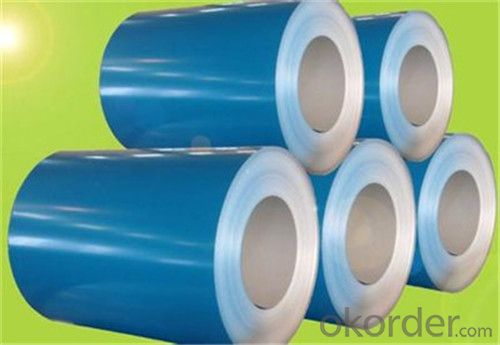
FAQ
1.What's your MOQ?
25MT, it is for one container.
2.Do you have QC teams?
Yeah, sure, our QC team is very important, they will keep the quality control for our products.
3. What's your normal delivery time?
Our delivery time about 10-20days for standard sizes, if you have other requirements like hardness and width ,it is about 20-40days. But don't worry ,we also try our best for the delivery time ,because time longer and our cost is higher.
- Q: Can steel coils be used in the manufacturing of machinery and equipment?
- Yes, steel coils can be used in the manufacturing of machinery and equipment. Steel coils have high strength and durability, making them suitable for various applications in the machinery and equipment industry. They can be shaped, cut, and formed into various components, such as frames, shafts, gears, and structural parts, to meet the specific requirements of different machinery and equipment. Additionally, steel coils can be further processed and treated to enhance their properties, such as through heat treatment or surface coatings, to improve their performance and longevity in the manufacturing process.
- Q: What are the different types of steel coil slitting blades?
- There are several different types of steel coil slitting blades, each designed for specific applications and materials. Some of the most common types include: 1. Circular slitting blades: These are the most commonly used blades for slitting steel coils. They are circular in shape and have a sharp edge that cuts through the coil as it rotates. Circular slitting blades can be made from various materials, such as high-speed steel or tungsten carbide, depending on the desired cutting performance and durability. 2. Arbors: Arbors are another type of steel coil slitting blade that is used in conjunction with circular slitting blades. They are cylindrical in shape and hold the circular blade in place, allowing for precise and consistent slitting of the coil. 3. Shear slitting blades: Shear slitting blades are used for cutting thicker and harder materials, such as stainless steel or aluminum. They have a straight edge and work by shearing the material apart, rather than cutting through it like circular blades. Shear slitting blades are typically made from high-quality tool steel to withstand the high forces involved in cutting thicker materials. 4. Crush cut slitting blades: Crush cut blades are used for slitting softer materials, such as paper or plastic. These blades have a blunt edge that crushes and tears the material, rather than cutting it cleanly. Crush cut blades are often made from materials like carbon steel or hardened stainless steel. 5. Razor slitting blades: Razor slitting blades are used for slitting delicate materials that require a clean and precise cut, such as thin films or foils. These blades have an extremely sharp edge that slices through the material without causing any damage or distortion. Razor slitting blades are typically made from high-quality stainless steel or tungsten carbide. It is important to select the appropriate type of steel coil slitting blade based on the specific application, material, and desired cutting performance. The choice of blade will greatly impact the quality and efficiency of the slitting process.
- Q: How are steel coils used in the production of roofing sheets?
- Roofing sheets cannot be produced without steel coils, as they are an integral part of the manufacturing process. These coils are typically composed of high-quality steel, which is renowned for its strength, durability, and resistance to corrosion. To convert these coils into roofing sheets, several steps must be followed. To begin, the steel coils are loaded onto a machine known as a decoiler. This machine effortlessly unrolls the coils, allowing them to be fed into the production line. By doing so, the decoiler guarantees a continuous supply of steel, ensuring an uninterrupted manufacturing process. Subsequently, the steel coils pass through a series of rollers. These rollers are responsible for molding the steel into the desired shape, which is specific to the type of roofing sheet being produced. Depending on the project's requirements, the rollers can create various profiles, such as corrugated or standing seam. Once the shaping process is complete, the steel sheets often receive a protective coating. This coating, which can be zinc or other metallic alloys, is referred to as galvanized or galvalume coatings, respectively. These coatings provide an extra layer of defense against rust and corrosion. Following the application of the protective coating, the sheets are generally cut to the desired dimensions. This can be achieved using shearing machines or other cutting tools, ensuring that the roofing sheets are appropriately sized for installation. Finally, the roofing sheets are carefully packaged and prepared for transportation to construction sites. They are typically bundled together and securely wrapped to safeguard them during transit. In conclusion, steel coils play a vital role in the production of roofing sheets. Through shaping, coating, cutting, and packaging processes, these coils are transformed into finished products ready for installation. By utilizing steel coils, roofing sheets are rendered strong, durable, and resistant to various environmental factors, making them a popular choice in roofing applications.
- Q: How are steel coils transported internationally?
- Steel coils are typically transported internationally by sea, as they are usually too heavy and bulky to be transported by air. The most common method of transportation is by using specialized shipping containers known as flatracks or open-top containers. These containers allow for easy loading and unloading of the steel coils onto the vessel. Before transportation, the steel coils are usually securely strapped or banded together to prevent any movement or damage during transit. They are then loaded onto the flatracks or open-top containers using cranes or forklifts. The coils are carefully placed and secured onto the containers to ensure stability and to prevent shifting during the journey. Once loaded, the containers are sealed and transported to the nearest port, where they are loaded onto cargo ships. These ships are specifically designed to transport heavy and oversized cargo. They are equipped with specialized handling equipment such as cranes and ramps to facilitate the loading and unloading of the containers. During the journey, the cargo ships follow predetermined shipping routes to reach the destination port. The duration of the journey depends on the distance between the origin and destination ports. Steel coils are typically transported in large quantities, so multiple containers may be loaded onto a single ship. Upon arrival at the destination port, the containers are unloaded from the cargo ship using cranes or ramps. The steel coils are then carefully removed from the containers and transported to their final destination, which may involve further transportation by road or rail. Throughout the transportation process, it is crucial to ensure that the steel coils are adequately protected from moisture, corrosion, and other potential damages. Special attention is paid to the handling and stowage of the coils to minimize the risk of any structural damage or deformation. In summary, steel coils are transported internationally by sea using specialized shipping containers. The coils are securely loaded onto flatracks or open-top containers, which are then transported by cargo ships to the destination port. Proper handling and stowage techniques are employed to ensure the safe and secure transportation of the steel coils.
- Q: What are the challenges in storing and handling steel coils?
- Storing and handling steel coils presents numerous obstacles due to their size, weight, and potential risks associated with transportation and storage. The following are some of the challenges: 1. Space requirements: Steel coils are typically large and bulky, necessitating ample storage space. Finding suitable storage facilities that can accommodate the size and weight of the coils can be difficult, particularly in urban areas with limited space. 2. Weight and handling: Steel coils can weigh several tons, making safe handling a challenge. Specialized equipment, such as cranes or forklifts with sufficient lifting capacity, is necessary to move and position the coils without causing damage or injury. 3. Stackability: Storing steel coils in a secure and efficient manner requires careful consideration of their stackability. Coils must be stacked in a way that prevents deformation or damage to the lower coils, ensuring stability and minimizing the risk of toppling. 4. Corrosion prevention: Steel coils are susceptible to corrosion, especially when exposed to moisture or harsh environmental conditions. Implementing proper corrosion prevention measures, such as protective coatings or climate-controlled storage, is essential to maintain the quality and integrity of the coils. 5. Safety risks: Handling steel coils can be hazardous, as they can unexpectedly shift during transportation or storage. This poses a risk to workers involved in the handling process. Adequate training, appropriate personal protective equipment (PPE), and strict safety protocols are vital to minimize the potential for accidents or injuries. 6. Transportation challenges: Transporting steel coils from manufacturing facilities to storage facilities or end-users can be logistically complex. Coordinating the loading, securing, and unloading of the coils onto trucks or shipping containers requires careful planning and adherence to safety regulations. 7. Quality control: Steel coils must be stored and handled in a manner that maintains their quality. Mishandling or improper storage conditions can result in deformations, scratches, or other defects that can impact the performance and value of the steel. In conclusion, the challenges encountered in the storage and handling of steel coils necessitate attention to detail, appropriate equipment, and adherence to safety protocols to ensure the integrity of the product, the safety of workers, and the efficiency of operations.
- Q: On a fixie frame what should i get an aluminum frame or a steel frame
- This Site Might Help You. RE: steel or aluminum on fixie? On a fixie frame what should i get an aluminum frame or a steel frame
- Q: What are the safety considerations when handling steel coils?
- There are several safety considerations that should be taken into account when dealing with steel coils. Firstly, it is crucial to wear the correct personal protective equipment (PPE), such as gloves, safety glasses, and steel-toed boots. This protective gear helps minimize the risk of injuries from sharp edges, flying debris, or accidental contact with the coils. Secondly, it is important to have a clear understanding of the weight and dimensions of the steel coils being handled. Steel coils can be extremely heavy, and improper lifting techniques can lead to back strains, muscle pulls, or even more severe injuries. Therefore, it is crucial to employ proper lifting techniques, such as bending the knees and maintaining a straight back, or using lifting equipment like cranes or forklifts when necessary. Moreover, steel coils can be unstable and susceptible to rolling or shifting during handling. To avoid accidents, it is vital to secure the coils adequately before moving or stacking them. This can be achieved by using appropriate lifting attachments, binding the coils together, or utilizing racks or other storage systems specifically designed for steel coils. Additionally, it is important to be aware of the potential hazards associated with the steel coils, such as sharp edges, oil or grease coatings, or even damage to the coils themselves. It is essential to inspect the coils for any irregularities or defects before handling them, as well as ensuring that they are stored safely and securely to prevent accidents. Lastly, proper communication and training are crucial when dealing with steel coils. Establishing clear channels of communication between workers is essential to ensure that everyone is aware of their roles and responsibilities. Furthermore, providing training on safe handling techniques, potential hazards, and emergency procedures can significantly reduce the risk of accidents and injuries. In conclusion, when handling steel coils, it is important to wear the appropriate PPE, employ proper lifting techniques, secure the coils adequately, be mindful of potential hazards, and ensure effective communication and training. By adhering to these safety considerations, the risk of accidents and injuries can be greatly diminished.
- Q: How are steel coils inspected for flatness using optical sensors?
- The process of inspecting the flatness of steel coils involves the use of optical sensors, which are part of a system known as optical flatness measurement. This system employs high-resolution cameras to capture images of the steel surface as it passes through the inspection line. To begin, the steel coil is unwound and conveyed over a roller table. While in motion, the optical sensors are positioned above the coil to capture images at regular intervals. These sensors are typically a combination of laser line projectors and high-resolution cameras. The laser line projectors emit a thin, straight line of laser light across the width of the steel coil. This laser line serves as a reference plane for measuring the flatness of the steel surface. Subsequently, the high-resolution cameras capture images of the laser line interacting with the steel coil. The captured images are then subjected to analysis using advanced image processing algorithms. These algorithms examine the deformation of the laser line on the steel surface and calculate the deviations from the flat reference plane. These deviations indicate any irregularities or variations in the flatness of the steel coil. The optical sensors possess the capability to accurately detect even the most minute deviations in flatness, measuring them in micrometers or smaller units. This enables manufacturers to identify and correct any flatness issues in the steel coils before further processing or shipment. In addition to measuring flatness, optical sensors can also identify other surface defects such as waviness, scratches, or dents. By incorporating multiple cameras and laser line projectors from different angles, a comprehensive inspection of the steel coil's surface can be achieved. Overall, the utilization of optical sensors for inspecting steel coil flatness offers a swift, precise, and non-contact method. By identifying and addressing any flatness issues early in the production process, manufacturers can guarantee the delivery of top-quality steel products to their customers.
- Q: Monopolistic competition means all of their products are identical like things in supermarket like milk. There are no high barriers to entry. Oil and steel are all same in all industries.
- While oil and steel may seem to be all the same, they are really not. There are many different grades of crude oil and many different types of steel.
- Q: What are the different methods of coil packaging for steel coils?
- Steel coils can be packaged using various methods, each with its own advantages and suitability for specific applications. Some commonly used methods include: 1. Strapping: Steel or plastic strapping is used to secure the coil and prevent unwinding or shifting during transportation. Strapping can be done manually or with strapping machines, providing a reliable and cost-effective packaging solution. 2. Stretch wrapping: This method involves tightly wrapping the coil with a stretch film. The film is stretched and wrapped around the coil, offering protection against dust, moisture, and damage. Stretch wrapping is suitable for lightweight coils and provides good visibility of the product. 3. Steel banding: This robust and heavy-duty method uses steel bands to secure the coil. It ensures high strength and durability, keeping the coil intact during transportation or storage. 4. Edge protectors: To safeguard the edges of the coil, edge protectors made of cardboard or plastic are used in combination with other packaging methods. These protectors provide additional support to prevent edge damage. 5. Wooden crates: For heavy or fragile steel coils, wooden crates are often used to provide maximum protection. The coils are placed inside the crate and secured with strapping or steel banding. Wooden crates offer excellent strength, stability, and can be customized to fit specific coil dimensions. 6. Paper interleaving: This method involves inserting layers of paper or cardboard between individual wraps of the coil to prevent scratching or marking. Paper interleaving is commonly used when stacking coils or when protecting a high surface finish. 7. Automated packaging systems: In larger-scale operations, automated packaging systems can be used. These systems are designed to handle and package coils using various methods such as strapping, stretch wrapping, or steel banding. They ensure increased efficiency, productivity, and consistent and secure packaging. The choice of coil packaging method depends on factors including coil size and weight, transportation requirements, required level of protection, and cost considerations. It is crucial to select the appropriate packaging method to ensure the safe delivery of steel coils to their destination.
Send your message to us
Galvanized Corrugated Steel Plate / Sheet in China CNBM
- Loading Port:
- Tianjin
- Payment Terms:
- TT or LC
- Min Order Qty:
- 140 m.t.
- Supply Capability:
- 500000 m.t./month
OKorder Service Pledge
OKorder Financial Service
Similar products
Hot products
Hot Searches
Related keywords
